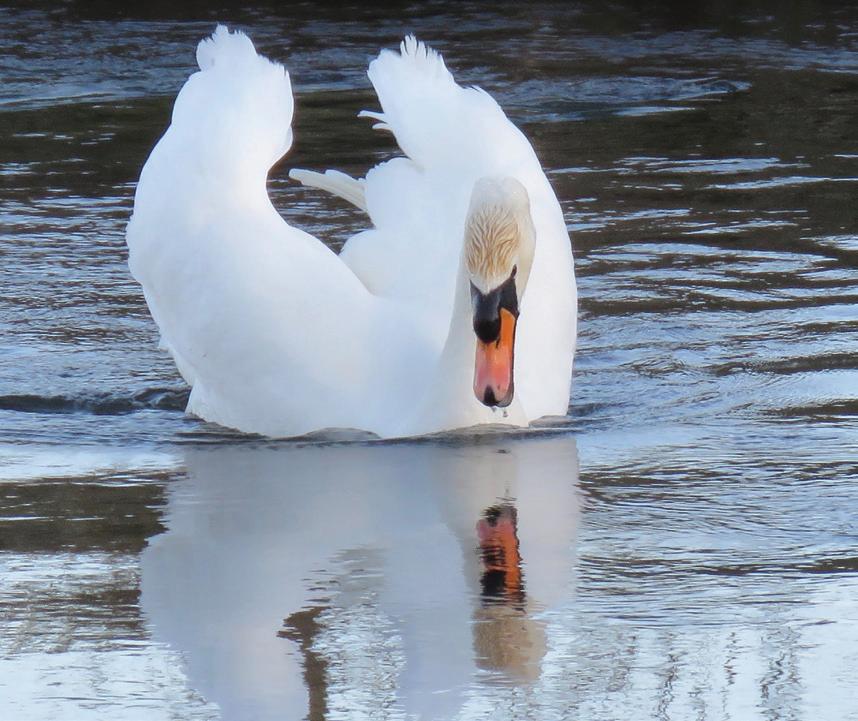
4 minute read
A royal among birds
from Viewpoint April 2023
by Dorset View
Words and image • Janine Pulford
Possibly the best-loved birds on our waterways, you can’t help but admire the gracefulness of mute swans as they swim serenely through the water.
Advertisement
They feed on aquatic vegetation, snails, small fish and worms, frequently upending to reach below the surface of the water. But they also dabble and graze on land. Their iconic snowwhite plumage that contrasts with an orange and black bill, and their long neck held in a graceful s-shape, make the birds instantly recognisable.
Pair for life
Pairing for life, the pen builds her nest from twigs and vegetation supplied by her partner, the cob. Five to 12 eggs are laid and incubated for five to six weeks. Fluffy grey cygnets hatch and stay on the nest for 24-48 hours before taking to the water. As they grow, they turn brown on top and white underneath. They stay with their parents for at least five months at which time they learn to fly. In some cases they stay with their parents to fly to a wintering area. They become predominantly white at a year old. Swans can pair bond from the age of two, but don’t generally breed until they are three years old.
The royal connection
The Crown holds the rights to claim ownership of all unmarked mute swans swimming in open waters across the countryside. These rights have existed since the 12th century when swans were considered an important food source for feasts and banquets. Although no longer caught for food, the Crown exercises rights to claim ownership of mute swans once a year.
This is carried out in a Swan Upping ceremony, mainly on certain stretches of the River Thames. The ownership of the swans is shared with the Vintners’ and Dyers’ livery companies, which were granted rights of ownership by the Crown in the 15th century.
Swan upping
Every year in the third week of July, the monarch’s swan marker, (this year for the first time since the end of the reign of Queen Elizabeth II, it will be the King’s swan marker) and swan uppers of the Vintners and the Dyers travel upstream to Abingdon on a five-day journey in traditional Thames rowing skiffs. They wear smart scarlet uniforms.
During the swan upping, the swan marker keeps a sharp eye out for cygnets. When the cry “All up!” is made, the baby swans are surrounded by the rowing boats and lifted from the water, counted, weighed, measured, and assessed for injury or signs of disease. If they belong to the Vintners or the Dyers (this is determined by cygnets’ parentage) they are ringed. The King’s birds are not ringed. A report detailing the number of swans, broods and cygnets is produced. The swan marker’s duty is to ensure the swan population is maintained and give talks to schools and charities on the subject of swan welfare and the annual swan upping census.
Swan upping has changed from a mostly ceremonial event to an important element of wildlife conservation.
Facts and myths
With a huge wingspan of around 238 centimetres and weighing in at around 12 kilograms mute swans can pose a threat if cornered or protecting their young or their territory. They have an intimidating hiss and will flap their wings. Territorial disputes can get nasty with swans sometimes fighting to the death. However the story that they can break a man’s arm is said to be a myth.
Mute swans partner for life and it is often said that if one dies, the other will pass away of a broken heart. Whilst this may be true in some instances, it is also known that after a period of grieving, swans will look for another partner.
The average lifespan of a mute swan is 12 years, although in a protected environment they can live for over 30 years.
Population
There are 6,500 UK breeding pairs of mute swans and 50,500 wintering birds (rspb.org.uk 2023).
A protected species under the Wildlife and Countryside Act 1981, swans, their nests and eggs are protected and it is illegal to harm, kill or disturb them in any way.
If eggs are abandoned it is against the law to take them and incubate them artificially. If you come across an injured bird call the RSPCA or another recognised animal rescue. There is a Swan Rescue Sanctuary at Wimborne. Telephone 01202 828166.
Swans don’t have many predators. Their main threats come from pollution, fishing tackle, cruel acts of vandalism and overhead power lines.








